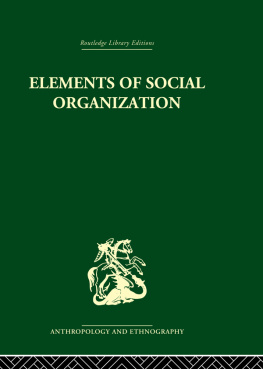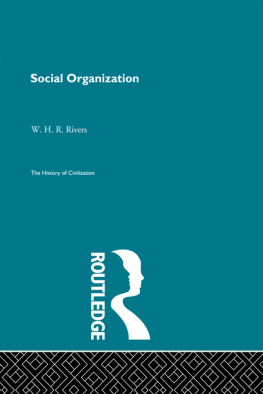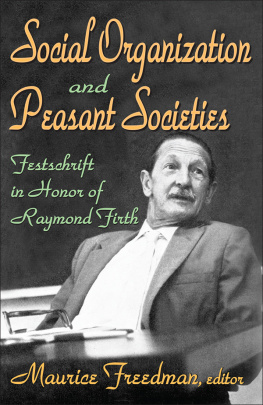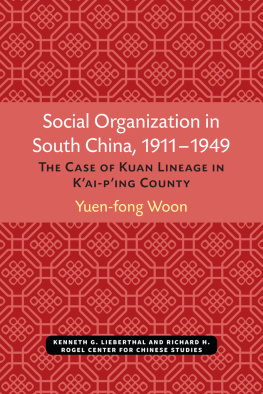Firth - Elements of Social Organisation
Here you can read online Firth - Elements of Social Organisation full text of the book (entire story) in english for free. Download pdf and epub, get meaning, cover and reviews about this ebook. City: Oxon England, year: 2004, publisher: Taylor & Francis (CAM);Routledge, genre: Religion. Description of the work, (preface) as well as reviews are available. Best literature library LitArk.com created for fans of good reading and offers a wide selection of genres:
Romance novel
Science fiction
Adventure
Detective
Science
History
Home and family
Prose
Art
Politics
Computer
Non-fiction
Religion
Business
Children
Humor
Choose a favorite category and find really read worthwhile books. Enjoy immersion in the world of imagination, feel the emotions of the characters or learn something new for yourself, make an fascinating discovery.
Elements of Social Organisation: summary, description and annotation
We offer to read an annotation, description, summary or preface (depends on what the author of the book "Elements of Social Organisation" wrote himself). If you haven't found the necessary information about the book — write in the comments, we will try to find it.
Firth: author's other books
Who wrote Elements of Social Organisation? Find out the surname, the name of the author of the book and a list of all author's works by series.
Elements of Social Organisation — read online for free the complete book (whole text) full work
Below is the text of the book, divided by pages. System saving the place of the last page read, allows you to conveniently read the book "Elements of Social Organisation" online for free, without having to search again every time where you left off. Put a bookmark, and you can go to the page where you finished reading at any time.
Font size:
Interval:
Bookmark:
Routledge Library Editions
ELEMENTS OF SOCIAL
ORGANIZATION

ANTHROPOLOGY AND ETHNOGRAPHY
Routledge Library Editions
Anthropology and Ethnography
RAYMOND FIRTH: COLLECTED WORKS
In 6 Volumes
I | Capital, Saving and Credit in Peasant Societies | Firth & Yamey |
II | Elements of Social Organization | Firth |
III | Primitive Polynesian Economy | Firth |
IV | Social Change in Tikopia | Firth |
V | Themes in Economic Anthropology | Firth |
VI | We, the Tikopia | Firth |
ELEMENTS OF SOCIAL
ORGANIZATION
RAYMOND FIRTH

First published in 1971
Reprinted in 2004 by
Routledge
2 Park Square, Milton Park, Abingdon, Oxon, 0X14 4RN, UK
Transferred to Digital Printing 2006
Routledge is an imprint of the Taylor & Francis Group
1951, 1956, 1961, 1971 Raymond Firth
All rights reserved. No part of this book may be reprinted or reproduced or utilized in any form or by any electronic, mechanical, or other means, now known or hereafter invented, including photocopying and recording, or in any information storage or retrieval system, without permission in writing from the publishers.
The publishers have made every effort to contact authors/copyright holders of the works reprinted in Routledge Library Editions Anthropology and Ethnography. This has not been possible in every case, however, and we would welcome correspondence from those individuals/companies we have been unable to trace.
These reprints are taken from original copies of each book. In many cases the condition of these originals is not perfect. The publisher has gone to great lengths to ensure the quality of these reprints, but wishes to point out that certain characteristics of the original copies will, of necessity, be apparent in reprints thereof.
British Library Cataloguing in Publication Data
A CIP catalogue record for this book is available from the British Library
Elements of Social Organization
ISBN 978-0-415-33016-9
Miniset: Raymond Firth: Collected Works
Series: Routledge Library Editions Anthropology and Ethnography
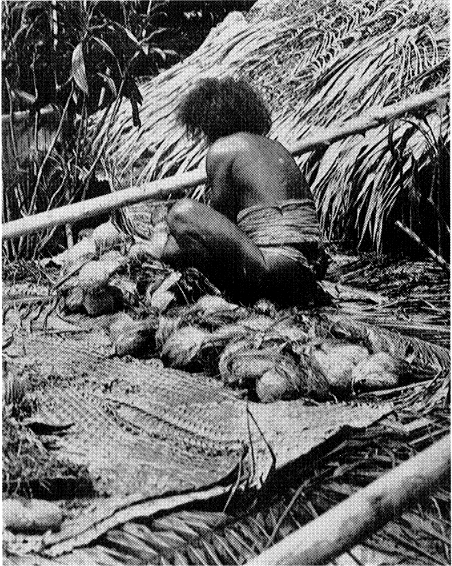
A corpse lies buried in the sand under the coconut matting. Pa Rangifuri, a man of Tikopia in the Solomon Islands, is preparing to pour a libation to the spirit of the dead man, who is his fathers brother. It is believed that the spirit is sensible of this offering.
ELEMENTS OF SOCIAL
ORGANIZATION
RAYMOND FIRTH

TAVISTOCK PUBLICATIONS
First published by C. A. Watts & Co. Ltd
in 1951, reprinted 1952
Second edition 1956
Third edition 1961, reprinted 1963, 1969
This edition published in 1971
by Tavistock Publications Limited
11 New Fetter Lane, London EC4.
SBN 422 73920 0 (hardbound)
422 75320 3 (paperback)
Raymond Firth, 1951, 1956, 1961, 1971
This book is available in both hardbound and paperback editions. The paperback edition is sold subject to the condition that it shall not, by way of trade or otherwise, be lent, re-sold, hired out, or otherwise circulated without the publishers prior consent in any form of binding or cover other than that in which it is published and without a similar condition including this condition being imposed on the subsequent purchaser.
LIST OF PLATES
(a) Hawaiian Figure of a God; (b) Black Madonna; (c) Maori Ancestor
I am indebted to the authorities of the Muse de lHomme, with the help of Mme. Denise Schaeffner, for Plate VII; to the Trustees of the British Museum, with the help of Mr. Adrian Digby, for Plates VIII (a) and X; to the Auckland War Memorial Museum, with the help of Dr. Gilbert Archey, Director, for Plate VIII (b and c); and to Mr. G. I. Jones for Plate IX (a). All other Plates are from my own collection. Plate V (lower) has been previously published by me in Social Problems and Research in British West Africa, Africa, April, 1947.R. F.
T HIS book was written as a re-crystallization of ideas first formulated in a series of lectures nearly twenty-five years ago. Many developments have since occurred in social anthropology, some mere fashions but most leading to more exact formulation of problems in the study and more precise investigation of them in the field.
New areas of interest have been explored. The recognition and construction of models has improved our analyses; hypotheses about the nature and relationships of social action have been refined. Not least as a factor in stimulating research and scholarly interchange of ideas has been the spread of social anthropology from its primary centre of development, Britain, through the general universe of scholars concerned with the sciences of man in the broadest sense.
The third edition of this book, ten years ago, took account of some of these developments. Since then, the study of systems of ideas, of myths, of symbols in different social and cultural conditions has taken an even more prominent place in the discipline. And though the anthropology of experience has not yet become a major interest, some concern for the primacy of personal feeling in a research or teaching situation has become manifest. In some of its forms this could imply a kind of solipsism, which could render comparability of observation difficult. A trend of another order has been a growing concern for the relation of the anthropologist to the wider society, including that of the peoples he has studied, and his obligation to them has been emphasized.
I myself have been involved in some of these movements of ideas. Moreover, since the last edition of this book I have again made visits to Malaysia (in 1963) and to Tikopia (in 1966), where much of my earlier field research was carried out, and have recorded and to some extent participated in the changes taking place in those societies.
But while new theory and new field material could certainly improve the book, it is not so much a statement of what is known in and about social anthropology as essentially a set of my own reflections on some of the general aspects of the study. As such, in this series of standard works in Social Science Paperbacks, it has seemed to me that it can stand reprinting in its present form, and perhaps can be regarded as a contribution to the foundations on which the modern sciences of man have been erected.
RAYMOND FIRTH.
London, March, 1971.
S INCE this book was first published, ten years ago, there has been a great development of interest in social anthropology. Public interest in the study has been stimulated partly by a desire to know more about the peoples of Asia and Africa who have recently attained political independence, and partly by a wider concern for any scientific discipline which can appear to throw more light on the refractory problems of modern social living. In more professional circles, colleagues in allied fields, e.g. sociology, psychology, political science, and even economics, have found it possible to integrate concepts from social anthropology, and some of the material provided by anthropological study, more closely with their own ideas and work. As a result, there is more understanding of what an anthropologist does, and more appreciation of the value of his comparative analyses of human behaviour, than ever before. At the same time, anthropologists have profited by this cross-fertilization of ideas. They have tended to give a less exotic, more precise and realistic air to their analyses. They have begun to give more attention to problems of recognizably general social importmigration, land tenure and utilization, social stratification, feudalism, local government, public health. They have increasingly left the primitive field and have examined with more confidence the institutions of rural, and even some urban, communities in the developed societies of the Orient and the West. They have given more depth to their work in various directions, notably in their increasing care for historical perspective.
Next pageFont size:
Interval:
Bookmark:
Similar books «Elements of Social Organisation»
Look at similar books to Elements of Social Organisation. We have selected literature similar in name and meaning in the hope of providing readers with more options to find new, interesting, not yet read works.
Discussion, reviews of the book Elements of Social Organisation and just readers' own opinions. Leave your comments, write what you think about the work, its meaning or the main characters. Specify what exactly you liked and what you didn't like, and why you think so.

